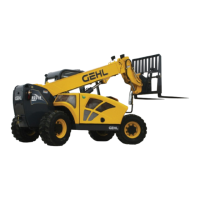50960066/AP0813 50 PRINTED IN U.S.A.
Inflate as necessary per the chart below:
12-16.5 NHS 10 PR: 65 psi (450 kPa)
NOTE: If the tires have been filled with water or
calcium chloride for ballast, a calcium chloride tire
pressure gauge MUST be used to check the tire
pressure.
To ensure proper load carrying capability, original
equipment tires comply with the specifications pub-
lished in the Tire and Rim Association Yearbook.
Replacement tires MUST meet the same specifica-
tions. When replacing tires, be sure all tires are of the
same type, quality and load rating, and the same size as
the original equipment. When removing tires, follow
industry safety practices. Deflate completely prior to
removal. After assembly of the tire on the rim, use a
safety cage or restraining device while inflating.
CHECKING HYDRAULIC OIL LEVEL
The machine must be on level ground with boom low-
ered and completely retracted. The fluid MUST be cool
when checking the reservoir level, to reduce the possi-
bility of overfilling the hydraulic system.
Open the right side engine cover and locate the sight
gauge below the battery compartment. The oil level
should be at the midpoint of the sight gauge. If the oil
level is down, or below the sight gauge, fill with the
required amount of oil. See the Lubrication chapter for
the type of oil to use.
IMPORTANT: Be careful when removing the
reservoir filler cap so that no dirt or other foreign
matter enters the hydraulic system. DO NOT
OVERFILL.
CHECKING BRAKE RESERVOIR
LEVEL
Remove the cover on the front of the frame. Remove
the reservoir cover to check the fluid level. If low, fill
to the proper level with the correct fluid. See the
Lubrication chapter for the type of fluid to use.
CHECKING TIRE PRESSURES
To ensure proper operating stability and extend tire
life, proper and equal tire pressure should be main-
tained in all four tires. Check tire pressures “cold.”
WARNING
Inflating or servicing tires can be dangerous.
Whenever possible, trained personnel should
service and mount tires. To avoid possible
death or serious injury, follow the safety pre-
cautions below:
1. BE SURE the rim is clean and free of rust.
2. Lubricate both the tire beads and rim
flanges with a soap solution. DO NOT use
oil or grease.
3. DO NOT place your fingers on the tire bead
or rim during inflation. Use a clip-on tire
chuck with a remote hose and gauge,
which allows you to stand clear of the tire
while inflating it.
4. NEVER inflate beyond 35 psi (240 kPa) to
seat the beads. If the beads have not seat-
ed by the time the pressure reaches 35 psi
(240 kPa), deflate the assembly, reposition
the tire on the rim, relubricate both parts
and re-inflate. Inflation pressure beyond 35
psi (240 kPa) with unseated beads may
break the bead or rim with explosive force
sufficient to cause death or serious injury.
5. After seating the beads, adjust the inflation
pressure to the recommended operating
pressure listed.
6. DO NOT weld, braze, or otherwise attempt
to repair and use a damaged rim.
Brake Fluid
Reservoir
Hydraulic Oil
Sight Gauge

